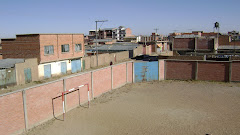This past week I had a great opportunity to visit some of the FAO’s star projects which they’ve implemented in a number of other countries. The idea is for families to grow their own food with family green houses. The context here is urban, something I haven’t experienced yet ( I have visited a number of rural greenhouses). The program is truly fascinating. Working with the local mayor’s office, families can apply for and receive all the materials for the construction of a green house. They also receive free training and technical support. The benefits are obvious- you remove yourself, at least partly, from radical global changes in food prices, you know the quality of the product you eat, you can create a small surplus to sell to neighbors or in the market, and you drastically better your diet by having a variety of vegetables.
After a first day of visiting the large plot in the middle of the city where the FAO has their research greenhouses ( far larger than family plots and unfortunately in the process of being moved because the city is about to build a judicial building there), and visiting a couple families’ greenhouses in the periphery of the city, I absolutely loved what I saw.
So I signed up for a two day intensive training course on how to set-up and maintain your own personal greenhouse. A number of beneficiaries had their greenhouses built, but still needed training. This would be the last training session, so I was lucky to find out about it when I did. I tagged along and has an inspirational experience.
We learned two forms of planting- hydroponic and organic. Some of the themes included how to maintain humidity levels, when to water, what ingredients and ratios you need for your soil base, how to diversify crops, how to create organic pesticides, how to maintain heat in below zero temperatures at night, how to clean and maintain plants, and probably coolest of all how to use all recycled materials.
In the context of the altiplano which is cold, high, and barren, these greenhouses are beautiful. It does have its uphill battles- families don’t like the change in diet from rice, pastas, and potatoes to more veggies. It takes work to maintain your tarp and produce what you need. If you don’t like what your growing you don’t see the incentive to grow. But for the families who carry through with it, they have seen great results overall.
A FAO Greenhouse

One of the members in my training group taking a look at a plot of lettuce
Another Visit With QBL

We visited the innaguration for a series of new chicken coops QBL financed in a small village in the low-lying andes mountains, 7 hours north of La Paz
Sunday, August 31, 2008
Subscribe to:
Post Comments (Atom)









No comments:
Post a Comment